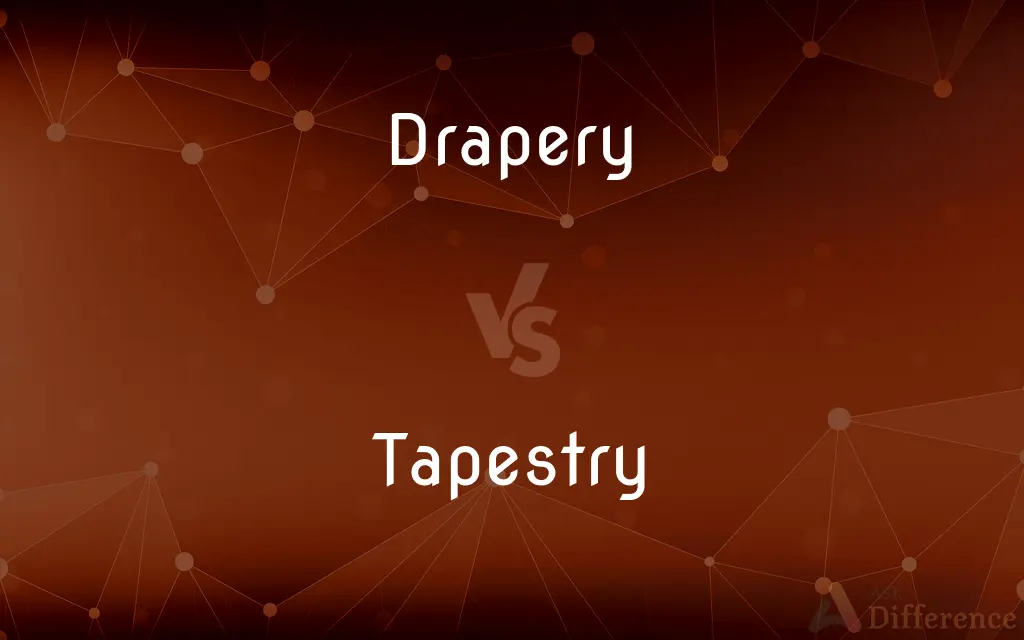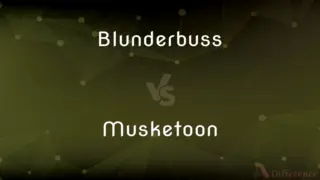Drapery vs. Tapestry — What's the Difference?
Edited by Tayyaba Rehman — By Fiza Rafique — Updated on April 8, 2024
Drapery involves fabric designed for window coverings or loose garments, focusing on aesthetic and functional use, whereas tapestry is a form of textile art, traditionally woven by hand on a loom, primarily for wall hangings or furniture coverings.

Difference Between Drapery and Tapestry
Table of Contents
ADVERTISEMENT
Key Differences
Drapery primarily refers to cloth materials used for window coverings, enhancing privacy and controlling light, while tapestry is an intricate, often pictorial weave used as wall hangings or upholstery, showcasing artistic designs. Draperies can be made from a variety of lightweight to medium-weight fabrics, focusing on functionality and aesthetics in interior design. On the other hand, tapestries are crafted from heavy textiles featuring historical, religious, or ornamental designs, serving as a form of storytelling and decoration.
The production of drapery involves the use of various fabrics such as cotton, silk, linen, or polyester, tailored to fit windows or as part of loose clothing, emphasizing utility and decor. In contrast, tapestry making is an art form that requires weaving colored weft threads through the warp on a loom, creating detailed pictorial or abstract designs. Draperies are often chosen for their ability to complement interior spaces, providing warmth, sound insulation, and privacy. Meanwhile, tapestries are valued for their artistic merit, historical significance, and the craftsmanship involved in their creation.
In terms of care and maintenance, drapery may require regular cleaning to remove dust and maintain fabric quality, which is usually simpler than tapestry care. Tapestries, due to their detailed weave and sometimes age, might need specialized cleaning methods to preserve their appearance and historical value. Drapery's role in interior design is versatile, as it can be easily changed to update a room's look or theme. Tapestry, however, is often a more permanent fixture, chosen for its aesthetic appeal and as a statement piece in a space.
Regarding cultural significance, drapery has been a practical element in homes for centuries, reflecting trends in interior design and material availability. Tapestry, conversely, has a rich history as an art form, often associated with storytelling, luxury, and status, depicting scenes from mythology, history, or the natural world.
Comparison Chart
Definition
Fabric used for window coverings or loose garments.
Woven textile art for wall hangings or furniture.
ADVERTISEMENT
Primary Use
Enhancing privacy, controlling light, and decoration.
Artistic decoration and storytelling.
Materials
Cotton, silk, linen, polyester.
Wool, cotton, silk, gold, and silver threads.
Care
Regular cleaning, easy maintenance.
Specialized cleaning, careful preservation.
Cultural Significance
Reflects interior design trends and functionality.
Symbolizes luxury, status, and historical storytelling.
Compare with Definitions
Drapery
Garments made from cloth that hangs loosely.
The gown's drapery flowed elegantly as she walked.
Tapestry
Artwork made by weaving colored threads.
She admires the craftsmanship in the ancient tapestry.
Drapery
Fabric used for window treatments to add aesthetic appeal.
The silk drapery in the living room adds a touch of elegance.
Tapestry
A heavy cloth featuring complex designs.
The museum's tapestry collection showcases various eras.
Drapery
Material draped for artistic or ceremonial purposes.
The stage was set with white drapery for the concert.
Tapestry
Handwoven textile used as upholstery.
The chair was covered in a luxurious tapestry fabric.
Drapery
Cloth hanging loosely in folds.
The artist captured the soft drapery around the model beautifully.
Tapestry
Decorative and historical wall hangings.
The tapestry on the castle walls adds to its mystique.
Drapery
A depiction of draped cloth in art or sculpture.
The sculpture's detailed drapery highlighted the artist's skill.
Tapestry
A form of textile art hung on the wall for decoration.
The medieval tapestry depicted a historic battle.
Drapery
Drapery is a general word referring to cloths or textiles (Old French draperie, from Late Latin drappus). It may refer to cloth used for decorative purposes – such as around windows – or to the trade of retailing cloth, originally mostly for clothing, formerly conducted by drapers.
Tapestry
Tapestry is a form of textile art, traditionally woven by hand on a loom. Tapestry is weft-faced weaving, in which all the warp threads are hidden in the completed work, unlike most woven textiles, where both the warp and the weft threads may be visible.
Drapery
Cloth or clothing gracefully arranged in loose folds.
Tapestry
A heavy cloth woven with rich, often varicolored designs or scenes, usually hung on walls for decoration and sometimes used to cover furniture.
Drapery
A piece or pieces of heavy fabric hanging straight in loose folds, used as a curtain.
Tapestry
A cloth embroidered with designs or scenes, especially one made in the Middle Ages.
Drapery
Cloth; fabric.
Tapestry
Something felt to resemble a richly and complexly designed cloth
The tapestry of world history.
Drapery
Chiefly British The business of a draper.
Tapestry
To hang or decorate with tapestry.
Drapery
(uncountable) Cloth draped gracefully in folds.
Tapestry
To make, weave, or depict in a tapestry.
Drapery
(countable) A piece of cloth, hung vertically as a curtain; a drape.
Tapestry
A heavy woven cloth, often with decorative pictorial designs, normally hung on walls.
Drapery
The occupation of a draper; cloth-making, or dealing in cloth.
Tapestry
(by extension) Anything with variegated or complex details.
Drapery
Cloth, or woollen materials in general.
Tapestry
To decorate with tapestry, or as if with a tapestry.
Drapery
The occupation of a draper; cloth-making, or dealing in cloth.
Tapestry
A fabric, usually of worsted, worked upon a warp of linen or other thread by hand, the designs being usually more or less pictorial and the stuff employed for wall hangings and the like. The term is also applied to different kinds of embroidery.
Drapery
Cloth, or woolen stuffs in general.
People who ought to be weighing out grocery or measuring out drapery.
Tapestry
To adorn with tapestry, or as with tapestry.
The Trosachs wound, as now, between gigantic walls of rock tapestried with broom and wild roses.
Drapery
A textile fabric used for decorative purposes, especially when hung loosely and in folds carefully disturbed; as: (a) Garments or vestments of this character worn upon the body, or shown in the representations of the human figure in art. (b) Hangings of a room or hall, or about a bed.
Like one that wraps the drapery of his couchAbout him, and lies down to pleasant dreams.
All the decent drapery of life is to be rudely torn off.
The casting of draperies . . . is one of the most important of an artist's studies.
Tapestry
Something that is felt to resemble a tapestry in its complexity;
The tapestry of European history
Drapery
Hanging cloth used as a blind (especially for a window)
Tapestry
A heavy textile with a woven design; used for curtains and upholstery
Drapery
Cloth gracefully draped and arranged in loose folds
Tapestry
A wall hanging of heavy handwoven fabric with pictorial designs
Common Curiosities
What is tapestry?
Tapestry is a form of textile art, traditionally handwoven, used for wall hangings or furniture coverings, often depicting complex designs.
How do drapery and tapestry differ in use?
Drapery is used for privacy, light control, and interior decoration, whereas tapestry serves as decorative art and storytelling.
What materials are used in tapestry?
Tapestry is typically made from wool, cotton, silk, and sometimes incorporates gold or silver threads.
What materials are used in drapery?
Drapery can be made from a variety of materials like cotton, silk, linen, or polyester.
Is tapestry still made today?
Yes, tapestry is still produced, both by traditional handweaving techniques and modern methods.
Are all tapestries old and antique?
Not all tapestries are old; contemporary artists also create tapestries using traditional and modern techniques.
What is drapery?
Drapery refers to fabric used for window coverings or loose garments, focusing on both aesthetic and functional aspects.
What role does drapery play in interior design?
Drapery enhances interior spaces by adding color, texture, and warmth, and can easily be changed to update a room's look.
Can drapery serve as a tapestry?
While drapery is mainly functional, it can be decorative but lacks the intricate weaving and storytelling aspects of tapestry.
Do draperies have historical significance?
Draperies reflect historical interior design trends and the availability of materials rather than serving as historical documents.
How do tapestries contribute to home decor?
Tapestries add a unique artistic touch and depth to home decor, often serving as a focal point in a room.
What depicts the cultural significance of tapestries?
Tapestries are valued for their artistic, historical, and sometimes symbolic significance, often depicting mythology, history, or nature.
How are draperies and tapestries cleaned?
Draperies often require regular washing or dry cleaning, while tapestries might need specialized care to preserve intricate weaves.
How does the functionality of drapery and tapestry differ?
Drapery provides practical benefits like insulation and light control, while tapestry is primarily artistic and decorative.
Can tapestries depict historical events?
Yes, many tapestries depict historical events, telling stories through their complex designs.
Share Your Discovery

Previous Comparison
Blunderbuss vs. Musketoon
Next Comparison
Group vs. CohortAuthor Spotlight
Written by
Fiza RafiqueFiza Rafique is a skilled content writer at AskDifference.com, where she meticulously refines and enhances written pieces. Drawing from her vast editorial expertise, Fiza ensures clarity, accuracy, and precision in every article. Passionate about language, she continually seeks to elevate the quality of content for readers worldwide.
Edited by
Tayyaba RehmanTayyaba Rehman is a distinguished writer, currently serving as a primary contributor to askdifference.com. As a researcher in semantics and etymology, Tayyaba's passion for the complexity of languages and their distinctions has found a perfect home on the platform. Tayyaba delves into the intricacies of language, distinguishing between commonly confused words and phrases, thereby providing clarity for readers worldwide.















































